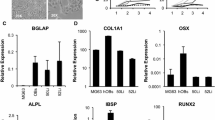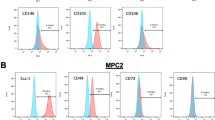Abstract
Transplantation of diffusion chambers (DC) containing osteoblast-like cells to extraskeletal sites has been highly studied and proven to be a useful technique to investigate the process of osteoblast differentiation and bone formation. To investigate the molecular basis of osteogenesis in DC, we examined the temporal pattern of gene expression of the proliferation marker histone H4, immediate early response genes (IEGs), c-fos, c-jun, c-myc, osteoblast phenotype-associated genes, osteocalcin (OC), osteopontin (OP), type I collagen (COL1A1), alkaline phosphatase (ALP), parathyroid hormone receptor (PTHR) and matrix modifying enzyme, matrix metalloproteinase-9 (MMP-9). DC containing ROS 17/2.8 were implanted intraperitoneally into rat hosts and cultured in vivo for various times up to 56 days. Histological analysis of von Kossa stained sections of the DC contents showed a well-organized connective tissue and the production of mineralized matrices/nodules. In contrast, histological examination of DC containing Rat-2 fibroblast cells revealed the lack of an organized mineralized matrix. Molecular analysis of DC containing ROS 17/2.8 cells at 0, 3, 10, 28, and 56 days demonstrated a time-dependent decrease in DNA content associated with cell death. In the surviving cells, an increase in histone H4 mRNA (consistent with an increase in cell proliferation) was evident by 3–10 days and thereafter expression returned to control levels. In vitro, ROS 17/2.8 cells expressed detectable levels of c-fos, c-jun, c-myc, OC, OP, ALP, COL1A1, and PTHR but not MMP-9. In vivo, the expression of c-fos increased 2-fold in 3–28 days and by 56 days was 4–5 fold above control levels. In 3–10 days, c-jun expression increased 1.6–1.8-fold above control levels. In contrast, by day 28, c-jun expression decreased to control levels, but increased to 2.1-fold above control by 56 days. c-myc mRNA expression increased 3-fold within 3 days and then dropped to below control values by 10–56 days. After transplantation in vivo, the expression of OC and PTHR decreased to undetectable levels. Similarly, ALP mRNA decreased to ≤28% of preimplantation values. In contrast, OPN mRNA levels increased up to 7-fold by day 10 and thereafter, returned to 1.7-fold above control values. COL1A1 mRNA decreased 2-fold at day 3 and increased to 3.5-, 1.6-, and 2.8-fold above control at days 10, 28, and 56, respectively. MMP-9 levels increased 5- to 10-fold by days 3–10, but fell to undetectable levels by 28–56 days. These results indicate that the formation of mineralized matrix (bone nodules) seen in the 56-day DC of ROS 17/2.8 cells was preceded by coordinate temporal expression of IEGs, matrix proteins, and matrix-modifying enzymes. Additionally, these results substantiate that measurement of molecular parameters in tissues formed by cells incubated in DC in vivo may be a useful predictor of the osteogenic process.
Similar content being viewed by others
Author information
Authors and Affiliations
Additional information
Received: 6 February 1998 / Accepted: 9 December 1998
Rights and permissions
About this article
Cite this article
Onyia, J., Hale, L., Miles, R. et al. Molecular Characterization of Gene Expression Changes in ROS 17/2.8 Cells Cultured in Diffusion Chambers In Vivo . Calcif Tissue Int 65, 133–138 (1999). https://doi.org/10.1007/s002239900671
Issue Date:
DOI: https://doi.org/10.1007/s002239900671




